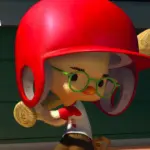A SUPER EDITOR’S CHOICE
♥️♠️♦️♣️
Scale pattern: the representative pattern of Zenitsu Agatsuma

Zenitsu Agatsuma, who is also a popular character, the pattern on his clothing is a pattern obtained by changing the scale pattern (鳞纹/うろこもん). This pattern is made up of regular triangles and inverted triangles. Because it looks like the scales of dragons, snakes and fish, it gets the name of scale pattern.

In the Yayoi era of Japan, earthen vessels arranged in a triangular pattern were often seen as funerary objects to protect the dead. The term scale pattern began to appear in the Kamakura era. Because it is believed to have the power to eliminate demons and curses, it is often used in combat clothing and weapons. In the Muromachi era, the scale pattern was also seen in the costumes of the incarnation of snakes and female ghosts in Noh or Kabuki, which are used to express the deep obsession of women. In the Edo era, it was regarded as a snake or a butterfly that shed its skin, and it had the meaning of getting rid of bad luck and rebirth. In addition, scale pattern also has the meaning of expelling shipwreck.
Yagasuri pattern (矢絣/やがすり)

The Yagasuri pattern is a pattern designed on the feather part of the arrow. Since it is impossible to return once an arrow is shot, it is often used in wedding celebrations to represent that girls will not return to their natal homes due to divorce or other changes in the future. After the Meiji and Taisho eras, Yagasuri pattern clothing was also popular among girls. For example, Yagasuri pattern clothing is also commonly seen in hakama clothing worn at university graduation ceremonies.

Vector wave pattern (青海波/せいがいは)

In addition, the vector wave pattern designed with blue sea waves originated in Persia and was spread to Japan by the Silk Road. It is said that this name is because it was used on the clothing of the Japanese Gagaku "Wave". The tatami of the Red Leaf House in the novel The Tale of Genji (1010) also depicts the scene of Genji dance vector wave pattern.

Visually, the vector wave pattern is composed of semicircles arranged like fish scales. It is taken from the repeated and stable waves on the sea. It is not like the passionate spirit of the famous Japanese painting The Great Wave off Kanagawa (かながわおきなみうら), but exudes A sense of stability and harmony, so it has the meaning of peace and tranquility in Japanese culture, and has always been regarded as an auspicious pattern by the Japanese.

Between the Hokusai museum and the Edo-Tokyo Museum in Tokyo, there is a hot spring hall Ryogoku Yuya Edo Yu, which was rebuilt from an existing building and partially added.
This is a design conceived by Kuboto Architects based on the hot spring hall in Edo era. The 20-meter-high white mouse-colored facade is based on the typical vector wave pattern favored by Japanese artist Katsushika Hokusai. The shape is like a fluttering design of a warm curtain, forming a soft curve.



Tortoise shell pattern with grape color: the representative pattern of Giyu Tomoioka/ Water Hashira
The Tortoise shell pattern is a pattern composed of multiple regular hexagons connected up and down, left and right. It is called the Tortoise shell pattern because it is similar to the tortoise shell. This pattern is a pattern that was introduced to Japan from ancient China during the Heian era. In traditional Chinese thought, the tortoise is a symbol of longevity and auspicious omens, so only the nobles' clothing could use this pattern at first.

Of all the Demon Slayers, only Giyu Tomoioka/Water Hashira's haori has different patterns on the left and right sides. The left half is the Haori pattern of his old friend, Sabito, and the right half is the color of the clothes of the elder sister Tomioka Tsutako (冨冈茑子/とみおかつたこ): grape color. In the Japanese text of Tomioka Tsutako, the pronunciation 茑 means birdvine and viscum, which is a vine of the grape family, Tsutako's clothes are designed in grape color, which can be taken as a detail.

In addition, in Japanese traditional culture, the pattern on the armor of Vessavana(毘沙門天/ びしゃもんてん), the God of Wealth in Seven Lucky Gods(七福神, shichifukujin in Japanese), is called "Vessavana tortoise shell pattern", which is also a pattern developed from the tortoise shell pattern, so the Japanese believe that the tortoise shell pattern also has a good fortune to attract wealth and treasure.

Sabito, 锖兔 , Giyu Tomoioka/Water Hashira's friend
Giyu Tomoioka's haori is called "half haori" by another protagonist Inosuke, so fans also call it this way. In fact, the kimono industry calls this kind of clothes with different patterns on both sides "changing one's body" (片身替/ かたみ‐がわり). In Japanese, "片身" means "half body", and both "half body" and "heritage" in Japanese are pronounced katami. Giyu Tomoioka wears haori like a heritage of the two passed people, is it like a person who has passed away is still by his side?


Butterfly wing pattern, the original Demon Slayer pattern: the representative pattern of Shinobu Kochou/ Insect Hashira

Shinobu Kochou is Insect Hashira, she is tiny and very beautiful. The butterfly wing pattern on her body is not a traditional Japanese pattern, but an original pattern of Demon Slayer. When she fights, the haori she wears unfolds in the wind like a beautiful butterfly. Shinobu Kochou used to wear pure white haori, but now the haori with butterfly wing pattern is her sister's heritage.
Butterfly is a very magical creature, from eggs, caterpillars, chrysalis, to beautiful adults flying in the air, constantly changing appearance, so it is also regarded as a symbol of reincarnation and immortality. There are martial arts families who use butterflies as family symbols, and the most famous one is the clan of the Heian era, the Heike's butterfly family symbol.

Butterfly patterns have appeared on clothing since the Momoyama era. Because of their gorgeous appearance and meaning, they have always been popular clothing patterns. But in some areas, butterflies are considered to be the messengers of hell and the underworld, who come to take away the souls of the dead, so some people think that the appearance of butterflies is an ominous omen.
Kanoko pattern (鹿の子/かのこ)
The Kanoko pattern is a pattern with spots on the upper surface of the deer body. Takemikazuchi (considered a God of thunder and a sword God, Takemikazuchi) is the guardian god of the Fujiwara house. This is a kind of dyeing technique that originated in the Ego era: Kanoko shibori (鹿子绞), because Kanoko shibori's production process is entirely manual operation, so at that time it was a kind of luxury item.

Kasumi pattern (霞/かすみ)

In Japanese, kasumi refers to the phenomenon that the distant view is blurred because water vapor condenses and disperses in all directions. And this pattern is often used on ancient screens.
Yukiwa pattern (雪轮/ゆきわ)
Yukiwa pattern is a pattern imitating the outline of snowflakes. Interestingly, in the era without microscopes, the Japanese have captured snow crystals as flower-like hexagonal prisms. The Yukiwa pattern is used on yukata worn in summer, as it is believed to bring coolness to the heat.


Karakusa pattern (唐草/からくさ )
The Karakusa pattern is a general pattern of vine plants. Because of the vine plant-like branches and stalks, the continuous growth of the stems, the reason for this is the abundance of growth, the prosperity, and the auspicious allegory of longevity. This book is actually from the Nara era, when ancient China entered Japan.

After seeing so many beautiful wagara patterns, have you aroused your interest in learning more about pattern knowledge and Demon Slayer? The costumes of the characters in Demon Slayer can be said to be very elegant, supported by rigorous clothing history, and integrated into the Self-innovation, it can be said that in this regard, Koyoharu Gotouge, the author of Demon Slayer, is very good.
At the same time, the theatrical version, which combines the last two episodes of the second season and the first episode of the latest season, is being released in many countries around the world. This theatrical version is also a pre-publicity for the upcoming Demon Slayer: Kimetsu No Yaiba- To the Swordsmith Village. So even though this theatrical version is just a compilation of excerpts from TV animation, it is still loved by fans all over the world.
Season 3 Demon Slayer: Kimetsu No Yaiba- To the Swordsmith Village will begin broadcasting in Japan on April 9th.
9th ATA Winner, the Fascinating Cultural Code Behind ‘Demon Slayer’ (1/2)
‘Demon Slayer’ Releases Season 3 New Posters
-END-










































Share your thoughts!
Be the first to start the conversation.